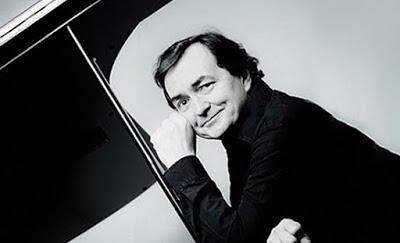by Paul J. Pelkonen
Pierre-Laurent Aimard brought exceptional Bach and Boulez to Carnegie Hall this season.
Photo © 2015 Universal Music Group/Deutsche Grammophon.
Alan Gilbert conducts the Philadelphia Orchestra (October 2014)
"Mr. Gilbert's experience as an opera conductor served to drive the story forward, with bright orchestra colors coming from the Philadelphia woodwinds and strings, contrasting with wine-dark figures in the brass and a repeated sense of perpetual forward motion throughout."
Esa-Pekka Salonen conducts the New York Philharmonic (October 2014)
"Mr. Salonen emphasized the narrative drive of the ballet, paying close attention to the all-important textures and double repetitions in the atmospheric opening scenes. The pianissimi were barely audible. Whispered strings blossomed into thematic ideas and descending bassoon figures held the promise of the work's explosive finale. The conductor was clearly at home in the long scherzo, dancing with the strings in the fast folk rhythms, the music anticipating the fury that was to come."
Mahler Symphony No. 7 with Michael Tilson Thomas (November 2014)
"Twittering bird-songs and a mysterious downward slide into a minor key open the first Nachtmusik. The mysterious march started, led off by the double basses and picked up by the rest of the huge orchestra, creating a mysterious journey through a strange landscape with only the illumination of starlight. This idyllic landscape gave way to the dark dream of the Schattenhaft movement, with its grinning skull-like oboe figures and the strings playing a wicked parody of the waltzes that so entranced the populace of Mahler's Vienna."
Jaap van Zweden conducts Beethoven (November 2014)
"Mr. van Zweden's approach was simple: adhere to Beethoven's tempo markings in each of the four movements. He was careful to illustrate the connection between the slow rumbling introduction and the celebratory dance that followed, capturing the dramatic fire and spirit of this movement in a way that was at once innovative and familiar. The Allegretto was played with momentum for once, its repeated, dragging bass figure stripped of funereal tread."
Dohnányi/Dvořák...without Dohnányi (December 2014)
Mr. Urbánski's interpretation of the Seventh waled the balance between classical rigor and Bohemian folk song that resounds through the best of Dvořák's music. The big theme in the first movement was red-blooded and bold, with strong playing from basses, brass and woodwind."
Pierre-Laurent Aimard plays Boulez at Zankel Hall (March 2015)
Leaning on the sustain pedal to make the piano ring like a carillon, Mr. Aimard presented this musical battle as a sort of chess match, with chiming sounds (the points) clashing with the gruff blocks. The battle ended with an agreement between the two musical forces to peaceably coexist.
Jordi Savalli's Viola da gamba at Weill Recital Hall (March 2015)
Mr. Savall's skilled and tasteful playing brought meaning into every unfamiliar note, from the slow, courtly dances to the rhythmic and adventurous Musettes of Marais. The decision to interrupt the parade of unfamiliar music with a transcription of Bach's Bourée from Cello Suite No. 4 gave the listener some very necessary context.
Dorothea Röschmann and Mitsuko Uchida at Carnegie Hall (April 2015)
Ms. Röschmann is an intense and deeply involved interpreter of these songs. Her voice, pliant and wide in the chest register moved smoothly up through the tricky passagio and to an upper register of clarity and power. She places a pronounced vibrato on some upper notes, but one had the sense of a carefully added effect rather than any vocal flaw.
Monteverdi at Carnegie Hall's Before Bach Festival (April 2015)
"When the voices entered with the opening Dixit Dominus the effect was extraordinary. Here was polyphony in all its detailed glory, with singers stretching syllables, repeating lines and in some cases adding whole new musical ideas but drawing the maximum detail and meaning from each syllable and word."
Marc-Andre Hamelin plays Beethoven at NJSO (May 2015)
"Mr. Hamelin's command of the keyboard was imperious. His right hand drove the relentless, searching rhythm of the first subject forward against Mr. Lacombe's loping accompaniment. His playing was crisp and lucid, combining with the orchestra in the initial thematic statement with a seriousness of purpose undershot with a current of playfulness and vitality that can make a performance of this concerto truly special."


